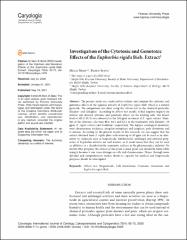Investigation of the Cytotoxic and Genotoxic Effects of the Euphorbia rigida Bieb. Extract
Citation
M. Mert, B. Betül (2020) Investigation of the Cytotoxic and Genotoxic Effects of the Euphorbia rigida Bieb. Extract. Caryologia 73(4): 65-75. doi: 10.13128/caryologia-1029Abstract
The present study was conducted to evaluate and compare the cytotoxic and genotoxic effects of the aqueous extracts of Euphorbia rigida Bieb. which is a natural pesticide. The comparison was done using the Allium test to the chemical pesticides Elandor (R) and Goldplan (R). According to Allium test results, it had negative impacts on mitosis and showed cytotoxic and genotoxic effects on the existing cells. The lowest level of MI (2.95 %) was observed in the 200 ppm treatment of E. rigida extract. Number of the aberrant cells were 88.1, 84.1 and 82.5 in the treatments with Elandor (R), 50 ppm, E. rigida extract and Goldplan (R) respectively. The highest cytological anomalies were chromosome stickiness, irregular metaphase and anaphase, pole deviations and C-mitosis. According to the present results of this research, we can suggest that the extract obtained from E. rigida plant with water up to 50 ppm can be used as an alternative to chemicals used as biopesticide. Antibacterial, antifungal and antiviral properties of Euphorbia extracts are well known, so it could mean that they can be used as additives or a disinfectant for inanimate surfaces in the pharmaceutics industry. No matter what purposes the extract of this plant is used, great care should be taken while using it because it can cause damage on cells and chromosomes. Hence, through more detailed and comprehensive studies about its capacity for medical and biopesticide purposes should be investigated.


















